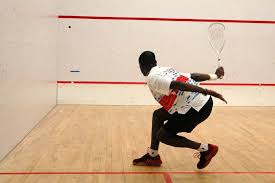As part of our essential Squash player tips series, we now look at the backhand techniques in Squash.
Whether you are an experienced or recreational player, junior or senior the backhand technique is an important skill to master, especially when playing a rally.

All squash coaches will educate players on a range of backhand techniques and even develop an entire session to perfect your style and adopt in a game, as it could be the dealmaker in a competitive match.
1. Keep your racket in front of you, not behind.
You will hit the ball with a flat hand if you keep your racket behind. You should always keep your eye on the ball and hit it with a swinging motion from low to high, hitting the sweet spot of your racquet with a downward motion.
2. Keep your eye on the ball.
Keeping your eye on the ball is a simple yet crucial tip for improving your backhand. Keeping your racket in front of you and keeping an eye on where the ball is will help you to better judge its speed, direction, and spin—all essential components to success in squash. By focusing on these elements, you will be able to better predict where the ball will land and be able to set up shots accordingly.
3. Do not twist your wrists or hit with a flat hand-ball contact will be lost
To hit the ball cleanly, you must keep your grip on the racquet as you swing through and through the ball. This means that when you swing back with your right hand, your left hand should still be at its original position (in front of where your right shoulder is). If either of these things change—if either of them rotate outwards as they swing towards the ball—then contact will be lost and the ball will not travel as far and may veer off course.
4. Hit the sweet spot and swing your racquet from low and up in a swinging motion
The sweet spot is the very centre of your squash racket. When you hit it with a ball, you will hear a different sound than if you hit any other part of your racket. This will help guide you to know where to place your swing as well as which direction it should go in order to hit this spot consistently.
Before starting out on this drill, make sure that both hands are positioned properly on the handle of your racquet: Keep one hand directly above (or slightly below) the other without twisting either wrist at all. Then swing back with both hands together until they are about even with one another before making contact with the ball—this ensures that both arms move equally when hitting backhands and helps prevent injury or discomfort while practicing them!
5. Be sure to watch the ball hit the floor in your opponent’s court after you have hit it
- Keep the ball in play
- Keep the ball in the court
- Avoid the ball going out of court
- Avoid the ball going out of bounds
6. Always keep practicing this shot and try different things, test what works best for you!
The backhand volley is your best friend, especially when you are in a tight situation and need to get out of trouble. It is also one of the most effective shots in Squash because it can be used both offensively and defensively. However, like any other shot, the backhand volley takes time and practice to master. So keep practicing, keep learning! Try different racquets, grips, and stances along with different ball positions to find what works best for you!
Practice until you become a master of the technique
Never stop experimenting! Test everything: try out different swings; use more or less wrist action; try hitting harder or softer balls; experiment with switching hands while serving on a regular basis etc…
Always remember to:
- Hold the racket in front of you, not behind.
- Keep your eye on the ball.
- Do not twist your wrists or hit with a flat hand-ball contact will be lost.
- Hit the sweet spot and swing your racquet from low and up in a swinging motion
Any of these are good tips to practice when hitting the backhand in squash, especially if you want to practice away from the court.

